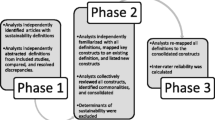Abstract
Person-Centered Care Planning is a recovery-oriented practice designed to meet the increasing demand to deliver person-centered care. Despite widespread dissemination efforts to train providers in person-centered care, behavioral health agencies are still struggling to implement person-centered care approaches. One of the barriers is poorly designed electronic health records that are not aligned to reflect the goal of providing individuals with meaningful choices and self-determination. The pitfalls of EHR design include service planning templates that rely on automated formats that are problem-driven and preclude the entry of unique information, whereas a well-designed EHR can become a key strategy for the delivery of person-centered care by having the functionality to reflect individual goals, actions, and natural supports. The promise and pitfalls of EHR design demonstrates the importance of having a treatment planning platform that allows providers to actualize person-centered care.

Similar content being viewed by others
References
Berwick DM. What ‘patient-centered’should mean: Confessions of an extremist. Health Affairs. 2009; 28(4): w555-w565.
New freedom Commission on Mental Health. Achieving the Promise: Transforming Mental Health Care in America. Final Report. DHHS publication number SMA-03–3832, Rockville, MD: 2003.
Stanhope V, Ingoglia C, Schmelter B, et al. Impact of person-centered planning and collaborative documentation on treatment adherence. Psychiatric Services. 2013; 64(1):76-79.
Tondora J, Miller R, Davidson L. The top ten concerns about person-centered care planning in mental health systems. International Journal of Personalized Medicine. 2014; (3):410-420.
Health Information Technology for Economic and Clinical Health Act, Title XIII of Division A and Title IV of Division B of the American Recovery and Reinvestment Act of 2009, Pub. L. No. 111-5, 123 Stat. 226 (2009).
Patient Protection and Affordable Care Act, Pub. L. No. 111-148, 124 Stat. 119, codified as amended at scattered section of the Internal Revenue Code and in U.S.C (2010).
Larrison CR, Xiang X, Gustafson M, et al. Implementation of electronic health records among community mental health agencies. The Journal of Behavioral Health Services & Research. 2018; 45(1):133-142.
HL7 International. Introduction to HL7 Standards. Available online at: http://www.hl7.org/implement/standards/index.cfm. Accessed July 20, 2020.
Tondora J, Miller R, Slade M, et al. Partnering for recovery in mental health: A practical guide to person-centered planning. Hoboken, NJ: John Wiley & Sons, 2014.
Adams N, Grieder D. Treatment planning for person-centered care: the road to mental health and addiction recovery: mapping the journey for individuals, families and providers. 2nd ed. San Diego, CA: Academic Press, 2014.
Tondora J, Pocklington S, Gorges A et al. Implementation of person-centered care and planning. From policy and practice to evaluation. Washington, DC: Substance Abuse and Mental Health Services Administration. 2005.
O'Brien J, Lovett H. Finding a way toward everyday lives: The contribution of person-centered planning. Harrisburg, PA: Pennsylvania Office of Mental Retardation. 1992.
Riahi S, Fischler I, Stuckey MI, et al. The value of electronic medical record implementation in mental health care: A case study. JMIR Medical Informatics. 2017; 5(1): e1.
Stanhope V, Matthews EB. Delivering person-centered care with an electronic health record. BMC Medical Informatics and Decision Making. 2019; 19(1):168-177.
The Joint Commission. Advancing effective communication, cultural competence, and patient- and family-centered care: A roadmap for hospitals. Oakbrook Terrace, IL: The Joint Commission. 2010.
Substance Abuse and Mental Health Services Administration. Federal Guidelines for Opioid Treatment Programs. HHS Publication No. (SMA) XX-XXXX. Rockville, MD: Substance Abuse and Mental Health Services Administration, 2015.
Comission on Accreditation of Rehabilitation Facilities. Behavioral Health Standards Manual, 2019. Available online at http://www.carf.org/Accreditation/QualityStandards/. Accessed on July 20, 2020.
Optum Behavioral Health Services. A Whole-Person Approach to Improve Outcomes For Medicaid Agencies And Their Members. Available online at https://www.optum.com/content/dam/optum3/optum/en/resources/brochures/WF252066_Behavioral_Health_Brochure_HR.pdf. Accessed on July 20, 2020.
Centers for Medicare and Medicaid Services. Fact sheet: Summary of key provisions of the 1915(c) Home and Community-Based Services (HCBS) waivers final rule (CMS 2249-F/2296-F). Baltimore, MD: Center for Medicare and Medicaid Services. Available online at https://www.medicaid.gov/medicaid/home-community-based-services/guidance/home-community-based-services-final-regulation/index.html. Accessed on November 5, 2020.
The National Council for Behavioral Health. CCBHC Demonstration, Early Results Show Expanded Access to Care, Increased Scope of Services, 2017. Available online at https://www.thenationalcouncil.org/BH365/files/2017/11/National-CCBHC-survey-write-up-FINAL-11-28-17.pdf. Accessed on July 20, 2020.
Finkelstein J, Knight A, Marinopoulos S, et al. Enabling Patient-Centered Care Through Health Information Technology. Rockville, MD: Agency for Healthcare Research and Quality, 2012.
Walker J, Darer JD, Elmore JG, et al. The road toward fully transparent medical records. New England Journal of Medicine. 2013; 370(1):6-8.
Deegan PE. A web application to support recovery and shared decision making in psychiatric medication clinics. Psychiatric Rehabilitation Journal. 2010; 34(1):23-28.
Adams N, Grieder D, Nerney T. Models, principles and values of person/family-centered planning. Chicago, IL: UIC National Research and Training Center on Psychiatric Disability. 2005.
Author information
Authors and Affiliations
Corresponding author
Ethics declarations
Conflict of Interest
The authors declare that they have no competing interests.
Additional information
Publisher’s Note
Springer Nature remains neutral with regard to jurisdictional claims in published maps and institutional affiliations.
Rights and permissions
About this article
Cite this article
Tondora, J., Stanhope, V., Grieder, D. et al. The Promise and Pitfalls of Electronic Health Records and Person-Centered Care Planning. J Behav Health Serv Res 48, 487–496 (2021). https://doi.org/10.1007/s11414-020-09743-z
Accepted:
Published:
Issue Date:
DOI: https://doi.org/10.1007/s11414-020-09743-z




